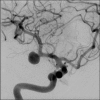Perianeurysmal vasogenic oedema (PAVO) following aneurysm embolisation: a unique case of asymptomatic long-term progression and review of the literature
- PMID: 30269088
- PMCID: PMC6169649
- DOI: 10.1136/bcr-2018-225625
Perianeurysmal vasogenic oedema (PAVO) following aneurysm embolisation: a unique case of asymptomatic long-term progression and review of the literature
Abstract
Perianeurysmal vasogenic oedema is a recognised although rare phenomenon following endovascular treatment of certain intracranial aneurysms. We present a unique case of asymptomatic perianeurysmal vasogenic oedema following bare platinum coil embolisation of an incidentally discovered right middle cerebral artery aneurysm that slowly increased over a period of 6 years before stabilising and regressing. During this time, the coiled aneurysm per se remained completely stable on serial magnetic resonance angiography.
Keywords: interventional radiology; neuroimaging.
© BMJ Publishing Group Limited 2018. No commercial re-use. See rights and permissions. Published by BMJ.
Conflict of interest statement
Competing interests: None declared.
Figures



References
Publication types
MeSH terms
LinkOut - more resources
Full Text Sources
Medical
